Is there a blog in existence that hasn’t gotten off at least one Monty Python reference? It’s hard to imagine, isn’t it?
We’re still dealing with the lingering effects of the cold spell, meaning it gets chilly at night and well into the morning, so I haven’t expected much to be happening on the arthropod front and haven’t really been looking. Today, however, while getting some gardening done, I managed to spot a couple of token arachnids.
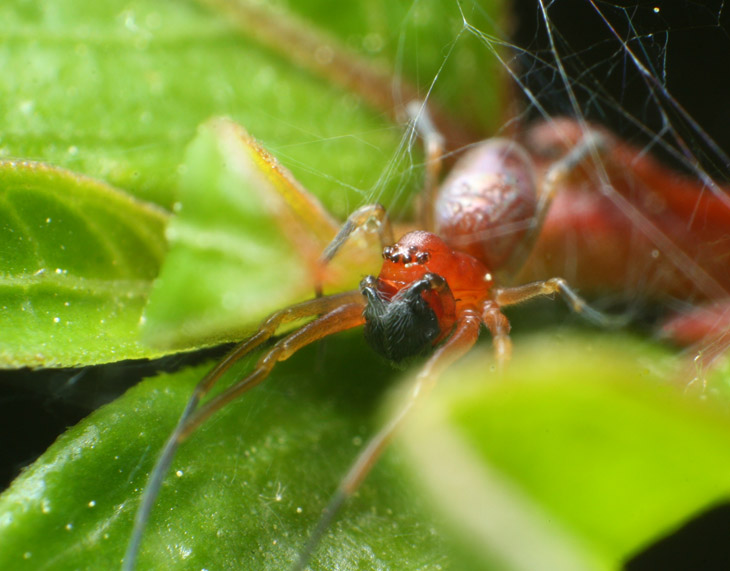
On a small potted tree I found a tiny red spider centered on a leaf, and going in for the extreme closeup displayed some serious pedipalps – not just a male of the species, but a proud one. This would appear, from the color and eye arrangement, to be a mesh web weaver, family Dictynidae.
Just in case you’re missing the significance of this from not having seen the times I’ve explained it before, the big black things in front of the spider are the pedipalps, mostly used to assist in manipulating food, but also used by the males to transfer sperm to the females; as such, they are typically much bigger in the males, club-ended rather than pointy, and serve as the most dependable way of telling gender in arachnids. You can check out this post and this one for more information if you dare.
While photographing that one, I spotted a jumping spider nearby that spooked as I tried to close in for the photo, but on returning a little later I found it back in place, quite close to the mesh web weaver. Notably, it was facing the red one and poised on ‘tiptoe,’ and suspected it had possibly sighted the smaller spider.
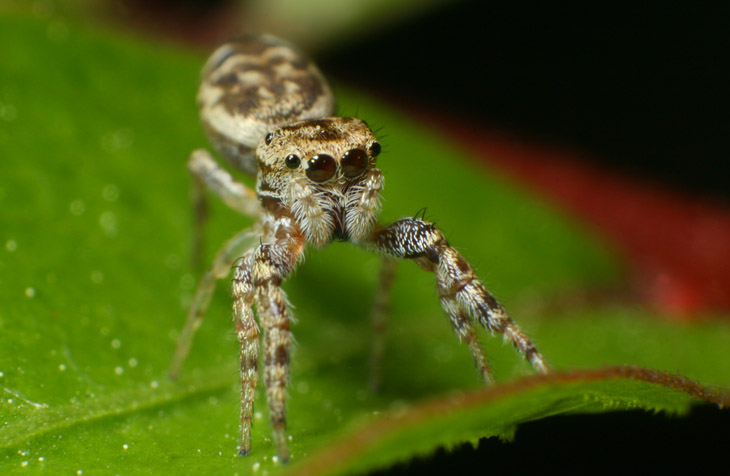
I watched to see if a capture was imminent, but after a minute it turned away, and I switched position to capture them both in the frame. I think it’s obvious that we’re not talking ‘big’ here; the red one is perhaps 3-4mm in body length.
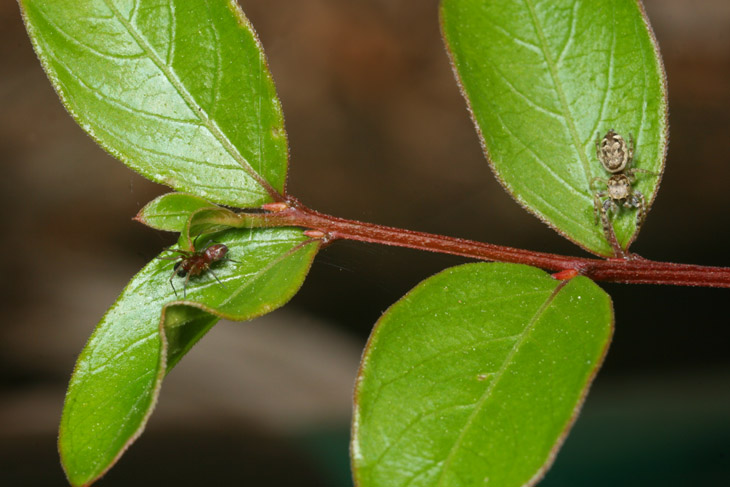
A few seconds after this image was taken, the jumper made a minor move which likely disturbed one of the mesh web weaver’s many little strands of web stretched along the leaves, because the red one leapt off the leaf and dangled from a webline, then quickly cast another strand into the breeze and clambered along it to a nearby twig, where it took up a hiding position. Whether the jumper was intending to eat the mesh web spider or not, the latter certainly believed it was likely.
Several years back, I observed two jumping spiders of mildly disparate size facing off on a railing, and quickly brought the camera to bear. In an instant they launched themselves at one another and ended up dangling several centimeters below the railing, spinning madly. Eventually they climbed back up the strand to regain their footing on the railing – or at least, one did. I was able to see them clearly, belly to belly, both facing the same way (and directly into the lens,) but the larger one was clearly in control, and had likely just killed the smaller one which was clasped upside down beneath it. Somehow, though, I lost that roll of film, one of only two that I’ve ever lost in my life (out of hundreds,) and it irked me no end.
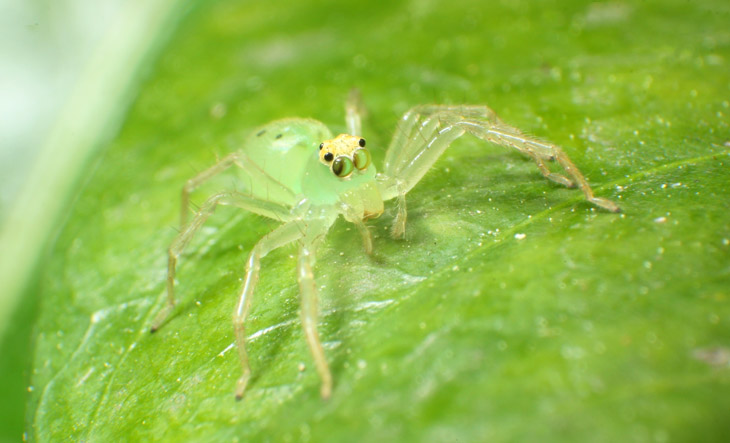
On the gardenia bushes nearby, I spotted my old friend the magnolia green jumping spider (Lyssomanes viridis) atop a leaf. They adore the gardenias, as do several other species, but the magnolia greens most like to sit underneath the leaves, lying in wait for all the insect species that take shelter on the undersides of leaves. Since this is a regular habit of mosquitoes, we’re more than happy to have the pale green spiders hanging out down there.
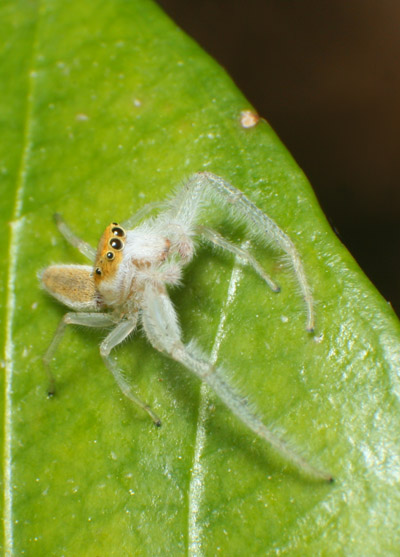 Another denizen very close by was a jumping spider fairly common around here, though BugGuide.net lists their range only as ‘Florida.’ This is a Hentzia mitrata, no apparent common name, so we will call them peachfuzz for obvious reasons. This one came very close to a magnolia green, but went past and tried to take shelter from my presence against a stem, before gaining the topmost leaf and viewing me alertly. Some jumpers are fearless, some are shy, and these seem to split the difference; after its attempts to disguise itself against the stem failed to work, it sat in plain view and intently watched me and the camera, in this image probably viewing the softbox reflector hanging out over the lens. More images of the same species from last year, including a fartistic one, can be found here.
Another denizen very close by was a jumping spider fairly common around here, though BugGuide.net lists their range only as ‘Florida.’ This is a Hentzia mitrata, no apparent common name, so we will call them peachfuzz for obvious reasons. This one came very close to a magnolia green, but went past and tried to take shelter from my presence against a stem, before gaining the topmost leaf and viewing me alertly. Some jumpers are fearless, some are shy, and these seem to split the difference; after its attempts to disguise itself against the stem failed to work, it sat in plain view and intently watched me and the camera, in this image probably viewing the softbox reflector hanging out over the lens. More images of the same species from last year, including a fartistic one, can be found here.
By the way, in stepping out this evening to check something outside while writing this post, I missed an opportunity. A magnolia green was sitting underneath a leaf, while opposite it on the top sat a longlegged sac spider, both visible as I shone a flashlight up from underneath the leaf – the silhouette of the green spider almost looked like the shadow cast by the sac spider, but displaced too far to one side, nicely surreal. I went in to get the camera and tripod, but the sac spider failed to heed my admonition to remain where it was, and had wandered away to another leaf before I returned – probably an irreverent juvenile. You know what I’m talking about.
Also, while researching the species for this post, I believe I stumbled across the correct identification of an earlier shot, the near-microscopic spider seen in this post. While mine had no visible yellow spot on the abdomen, it certainly looks like it could be a Theridula emertoni, a type of cobweb spider.
It was one other find that I was most pleased about, though. Spotting some slender legs moving behind a potted plant, I carefully drew out the entire pot to get a view without disturbing the resident. Expecting to see another spider, I instead faced a newborn praying mantis. Between never having found an egg sac, and the inordinately cold weather, I wasn’t expecting any such appearances for at least another week or more. This one proved to be quite shy, and every time I managed to get it into the viewfinder it leapt away to another perch – I eventually couldn’t locate it again and I still hadn’t snagged a photo. Frustrated by this lack but still pleased to actually see evidence, I moved on to other tasks, only to find it (or a similar one) about a half-meter away in the opposite direction from what it was last seen moving. Ah, the old ‘fake and double-back’ trick – not a tactic I expected from one so young…
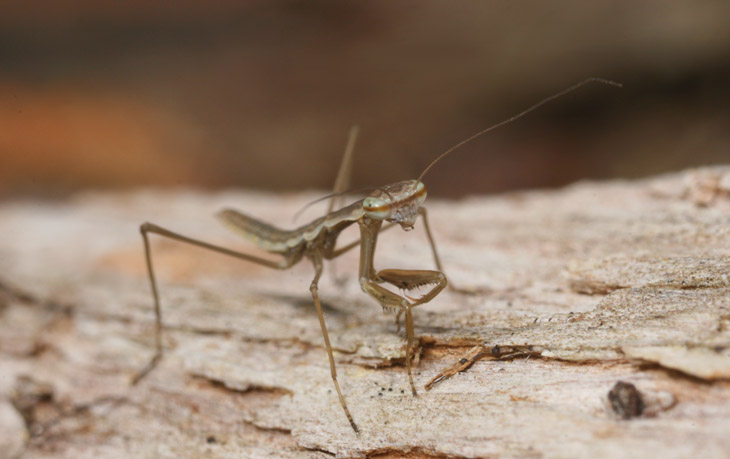
Seen here on the same stump that the Copes grey treefrog was favoring earlier this year, this Chinese mantis (Tenodera sinensis) was reluctant to provide me with a head-on shot, but my natural charm and charisma paid off (you should do something about that cough.) Only 10mm long and weighing – man, how would anyone even weigh one of these? It’s lighter than a sesame seed – this minuscule mantis marks the first of the season, at least for me, and could only be a couple of days old at the most. I actually have a pair of egg cases in the mail to me right now, specifically so I can try to photograph their emergence in excruciating detail. And speaking of excruciating detail…
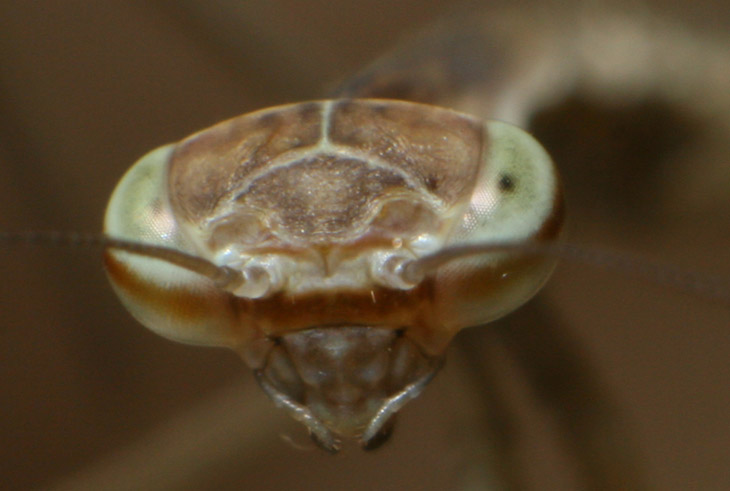
If you look close, you can actually make out the facets of the compound eyes. Bearing in mind that the eyes are 2mm across at the widest point, I’m pleased to capture that kind of detail. Also note that, at this magnification, the false pupil is quite vague, but that’s partially because it’s slightly out of focus.
So, yeah, I’m pleased with how the day came out. And I’ve gotten an appropriate start on the subjects that will undoubtedly appear here many more times throughout the year.




















































